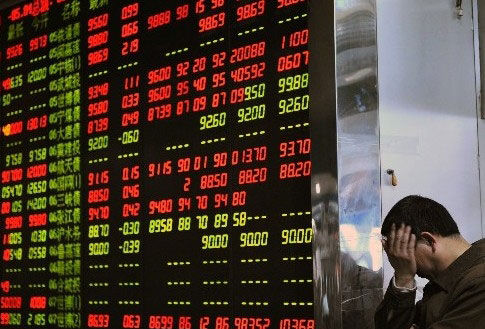双语:中国沪深股市冰火两重天
 中国沪深股市冰火两重天
中国沪深股市冰火两重天摘要:中国股市令人想起狄更斯(Charles Dickens)的作品。内地股票投资者既经历着最好的时代,又经历着最坏的时代。这出“双城记”在深圳和上海之间展开。深证综指(Shenzhen Composite)现在的表现使之成为亚洲股市新的明星股指,而上海股市则是内地更知名、更成熟的股票市场。
Chinese equity markets are displaying echoes of Dickens as investors in mainland stocks are experiencing the best of times and the worst of times。
中国股市令人想起狄更斯(Charles Dickens)的作品。内地股票投资者既经历着最好的时代,又经历着最坏的时代。
This tale of two cities plays out between Shenzhen, whose composite index is Asia’s new star performer, and Shanghai, the better known and more established of China’s mainland markets。
这出“双城记”在深圳和上海之间展开。深证综指(Shenzhen Composite)现在的表现使之成为亚洲股市新的明星股指,而上海股市则是内地更知名、更成熟的股票市场。
Following the recent rout in global emerging markets, the Shenzhen composite – home to China’s small-caps index – is up 13.8 per cent this year, outpacing gains in the next best Asian market, the Philippines。
在全球新兴市场近期暴跌之后,深证综指今年迄今上涨13.8%,增幅高于亚洲表现第二佳的市场——菲律宾。深市也是中国中小板指数的诞生地。
The move is not a reflection of new-found confidence in China. The Shanghai Composite remains Asia’s most unloved index, having fallen 8.6 per cent this year, partly due to the perception that it is a proxy for China’s old economy。
这种变化并不意味着投资者对中国重拾信心。上证综指(Shanghai Composite)仍是亚洲最不受欢迎的股指,今年已下跌8.6%,这在一定程度上是因为人们将它视为中国旧经济的代表。
Financials, energy and materials companies account for about 70 per cent of the Shanghai market, mostly state-owned enterprises. While many analysts believe the most recent data suggest China’s economy is stabilising, it has not been enough to alter the view that the country will need to embark on a big restructuring of its entire economic model, away from investment and towards consumption. Investors are already making the switch。
金融、能源和原材料类公司占据上海股市约七成,其中大多数是国有企业。尽管许多分析师认为最近的数据表明中国经济企稳,但这不足以改变原有的观点,即中国需要开始大幅重组整个经济模式,从促投资向促消费转移。投资者已经开始调整方向。
Though China’s markets are largely closed to foreign investors, a similar story has played out within Hong Kong. The H-share market – mainland companies listed offshore – has fallen almost 15 per cent this year. Yet the GEM board, a small-caps index of Chinese companies, has risen 8.5 per cent。
尽管中国市场在很大程度上不对外国投资者开放,但类似的场景同样在香港上演。H股市场——由离岸上市的中国内地公司组成——今年跌幅近15%。但由中国公司组成的小盘股指数香港创业板指数(Gem)却上扬8.5%。
“It has a lot to do with the relative traction within the economy. Big-caps are reflecting a global scepticism towards China, and that growth is slowing,” says Jake Lynch, who covers Asian small-caps at Macquarie. “There is a lot of talk about more friendly policies towards private companies . . . perhaps the market is also latching on to that。”
“这与经济内部的相对吸引力有关。大盘股反映出全球对中国的怀疑,以及中国的增长在放缓,”麦格理(Macquarie)研究亚洲小盘股的杰克•林奇(Jake Lynch)表示,“现在很多人在讨论对私有公司采取更友好的政策……或许市场听取了这些信息。”
Much of the negative drag, both in H shares and Shanghai, has come from the banking sector, the biggest on both indices. China’s 2008 stimulus package pushed banks into lending huge amounts of cash for infrastructure and construction projects. As that debt comes due, many believe that the country’s banks will need a bailout once non-performing loans begin to stack up。
H股和上海股市的主要阻力来自银行板块,它也是两个市场规模最大的板块。中国2008年的刺激计划导致银行放出大量贷款,用于基建和建筑项目。在许多人看来,当这些贷款到期时,随着不良贷款开始累积,中国的银行将需要纾困。
In June, fears about the banking system spread when the People’s Bank of China refrained from adding new liquidity into money markets, causing a jump in interbank lending rates. Financial shares tumbled as a result, leaving many banks trading at a price-to-book ratio below one, an indication that the market did not have faith in the value of a company’s stated assets。
6月份,中国央行(PBoC)拒绝为货币市场注入新的流动性,致使银行间拆借利率飙升,这导致外界对银行体系的担忧大肆蔓延。金融股因此暴跌,许多银行市账率不到1倍,这表明市场不信任银行公布的资产价值。
By contrast, Shenzhen’s three separate boards – which together make up the composite index – are virtually financials free。
相比之下,组成深圳股市的三大板块几乎不包含任何金融股。
Its main board features property stocks, such as China Vanke, and consumer-related companies such as electronics manufacturer ZTE. The rest of the market consists of small and medium-sized enterprises on its SME board, and high-growth companies on the GEM board. Together they carry some weight – Shenzhen has a total capitalisation of $1.34tn, recently overtaking Australia’s ASX 200.
主板包含万科集团(China Vanke)等地产股,以及电子产品生产商中兴(ZTE)等消费品公司。深市还包括中小型企业组成的中小企业板,以及高增长公司组成的创业板。它们加起来颇有分量——深市总市值达1.34万亿美元,近期超过了澳大利亚的ASX 200指数。
While the resurgent property market has helped, Shenzhen’s strength is largely a reflection of the scramble within China to invest in companies still capable of delivering rising profits. That is clearest on Shenzhen’s ChiNext index – home to small, fast-growing technology, media and healthcare companies. It is up more than 65 per cent this year, outpacing gains almost anywhere else in the world, amid a gold rush from Chinese retail punters。
虽然复苏的房地产市场起到了作用,但深市的强势主要反映出中国国内投资者在争相投资仍有能力提升利润的公司。最明显的例子是深市创业板(ChiNext)指数,它由快速增长的小型技术、媒体和医疗类公司组成。由于中国散户投资者纷纷涌入,创业板指数今年已经上涨逾65%,涨幅超过世界上几乎所有其他指数。
“Retail investors like to play small-caps because they feel it’s easier to have growth,” says Heather Hsu, strategist at CLSA Fortune. “Due to a lack of good quality names to invest in, they are willing to pay a premium。”
“散户投资者喜欢投资小盘股,因为他们认为小盘股更容易增长。”财富里昂证券(CLSA Fortune)的策略师许蕙蕙表示,“由于缺乏可以投资的优质股,他们愿意支付溢价购买小盘股。”
That willingness is certainly clear when it comes to valuations. The Shenzhen composite trades at about 20 times earnings, compared with just nine times for the Shanghai market. The ChiNext is even punchier, on a price to earnings ratio of 45, its highest level since 2010.
从估值来看,这种意愿无疑十分强烈。深证综指市盈率约为20倍,而上海股市仅有9倍。创业板更加抢眼,市盈率为45倍,是2010年以来的最高值。
With earnings growth forecast to be over 50 per cent this year, some analysts say there is some justification for the heady prices. But others have their doubts。
由于今年的预期盈利增长超过50%,一些分析师认为,股价高涨是有理由的。但另一些人心存疑虑。
“It seems like it has a bubble; valuations are extremely high”, says Chen Li, head of China equity strategy at UBS Securities. “Clearly, there could be a big decrease。”
瑞银证券(UBS Securities)主管中国股票策略的陈李表示:“看上去有泡沫,因为估值已达到极高。很明显,股价可能将大幅下降。”
Shifts in investment habits have also played a part in Shenzhen’s rise. Over the past seven years, total assets under management at Chinese mutual funds has stayed roughly the same. Yet the number of active funds has more than doubled, according to Mr Chen, meaning that each fund is smaller in size。
投资习惯的转变也促成了深市的上扬。在过去7年,中国共同基金管理的总资产大体维持不变。但陈李表示,活跃的基金数量翻了一番还多,这意味着每只基金的规模缩小了。
That change has enabled some funds to look towards smaller stocks, having previously been restricted to large, liquid equities, such as the state-owned companies listed in Shanghai。
这种变化让一些基金能投资更小型的股票。它们之前只能投资流动性高的大型股,例如在上海上市的国有企业股票。
And Chinese funds often have a very limited performance horizon. Many portfolio managers are judged on a quarterly or monthly basis, giving extra incentive to take riskier, short-term bets。
而且,中国基金的业绩通常被放在一个很短的周期内衡量。许多投资组合经理的业绩评估是按季度或月度,因此增加了他们进行短期冒险赌博的动力。
- 热词聚焦:美国股市走向呈“螺旋式下降”2011-09-26 11:29
- 双语:微博预测股市走向准确率可达八成2011-09-22 13:37
- 热词:美国“信用评级下调”致股市暴跌2011-08-10 10:19
- 股市新词:“狼市”英文怎么说(图)2011-01-24 10:13
- 微博用户心情指数竟可预测股市行情2010-10-25 11:46
- 股市投资必备三大“救心丸”(图)2008-11-14 16:19
- 留学动态:股市“熊”了 留学“牛”了2008-11-13 09:50
